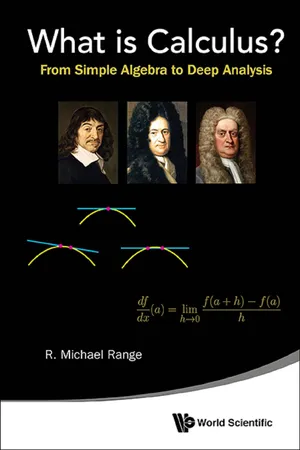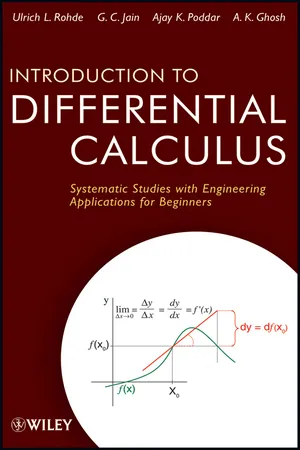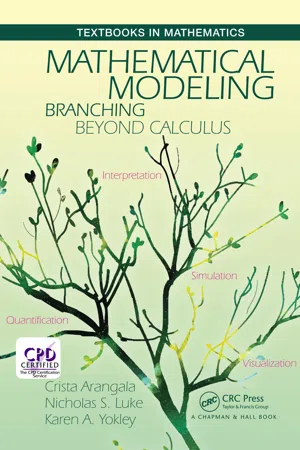Mathematics
Rates of Change
Rates of change refer to how one quantity changes in relation to another. In mathematics, it is often represented as the slope of a line on a graph, indicating the speed or direction of change. It is a fundamental concept in calculus and is used to analyze and predict the behavior of functions and real-world phenomena.
Written by Perlego with AI-assistance
Related key terms
8 Key excerpts on "Rates of Change"
- eBook - ePub
- Morris Kline(Author)
- 2013(Publication Date)
- Dover Publications(Publisher)
All these questions and many others that we shall encounter in the present and later chapters bedeviled the mathematicians of the seventeenth century, and hundreds of capable men worked on them. When Newton and Leibniz made their contributions to the calculus, it became clear that all of the above problems and others too could be solved by means of one basic concept, the instantaneous rate of change of one variable with respect to another. Hence we shall begin with this concept.16–3 THE CONCEPT OF INSTANTANEOUS RATE OF CHANGE
There are three closely related ideas: change, average rate of change, and instantaneous rate of change. These three ideas should be carefully distinguished. The concept of change itself is by now a familiar one. When a ball is thrown up into the air, its height above the ground changes. The pursuit of physical problems involving functions soon obliges one to consider not just the mere fact of change but the rate of change of one variable with respect to another. In the case of a ball thrown up into the air, one might wish to know what initial speed will enable the ball to reach a height, say of 100 feet, or what speed the ball has on returning to the ground; that is, information about the speed, which is the rate of change of height with respect to time, is desirable. The statement that the earth travels around the sun in one year is a fact about rate of change rather than about mere change. Our great concern in this age for faster transportation and communication is a concern with rate of change. Circulation of the blood in one’s body means quantity of blood per unit time passing through a specific artery or a collection of arteries, and here, too, it is rate of change which counts. The rate of physiological activity, that is the metabolic rate, measured in terms of the rate of consumption of oxygen per second, is a rate of change. To sum up: the rate of change of one variable with respect to another is a physically useful quantity in many situations.The Rates of Change which are of interest to laymen and even to many specialists are average rates. Thus, if a motorist travels 500 miles in 10 hours, the average speed, i.e., the distance traveled divided by the time of travel, is 50 miles per hour. This average speed is what usually matters, and in most instances it is quite irrelevant that the driver may occasionally have stopped for food and thus had no speed at all during those periods of the trip. Most people like to increase their wealth and are satisfied if the rate of growth, that is the growth in wealth per month or per year, is appreciable. The increase of a country’s population is usually measured per year because this average rate tells the story which is of importance for most purposes. - eBook - ePub
Teaching Secondary School Mathematics
Research and practice for the 21st century
- Merrilyn Goos, Gloria Stillman, Sandra Herbert, Vince Geiger(Authors)
- 2020(Publication Date)
- Routledge(Publisher)
Chapter 8 , middle secondary students have difficulties with the concept of rate, so it is not surprising that students of calculus have difficulties with differentiation that have persisted over many years (Hashemi, Abu, Kashefi & Rahimi, 2014; Orton, 1983).Figure 12.6Drawing a tangent to the curve at the point (–3.5, 0.9)Figure 12.7Drawing secants approaching the tangent to the curve at the point (–3.5, 0.9)Figure 12.8Constant rate of change of height of a stack of plastic cups, per cupStudents need many early experiences with constant (e.g., stacking plastic cups, see Figure 12.8 ) and non-constant Rates of Changes (e.g., shortest-path problems, see Figures 12.9 and 12.10 ) and being asked to distinguish between these, using information from all three representations.The key question being asked is how does the rate at which the y values are changing compare with the rate at which the x values are changing? Distinguishing between change (i.e., Δx or Δy) and rate of change (i.e.,) causes problems for students. They have difficulty understanding the difference between a difference and a ratio of differences.Δ yΔ xIn the following exchange, for example, the students are trying to answer a question about the rate at which the total distance travelled by a runner is changing as the runner traverses a field via one of 18 equally spaced drink stations along one side of the field (see Figure 12.10 ). The runner must travel via only one drink station after entering through one gate and leaving via a second gate.Figure 12.9Varying rate of change of total distance run with station distanceFigure 12.10Path and distance travelled by runnerThomas: Does the total distance change at the same rate as you travel via station 1, or 2 or 3 or 4?Andrea: Yes.Thomas: - eBook - ePub
Math for Programmers
3D graphics, machine learning, and simulations with Python
- Paul Orland(Author)
- 2020(Publication Date)
- Manning(Publisher)
This chapter covers8 Understanding Rates of Change
- Calculating the average rate of change in a mathematical function
- Approximating the instantaneous rate of change at a point
- Picturing how the rate of change is itself changing
- Reconstructing a function from its rate of change
In this chapter, I introduce you to two of the most important concepts from calculus: the derivative and the integral. Both of these are operations that work with functions. The derivative takes a function and gives you another function measuring its rate of change. The integral does the opposite; it takes a function representing a rate of change and gives you back a function measuring the original, cumulative value.I focus on a simple example from my own work in data analysis for oil production. The set up we’ll picture is a pump lifting crude oil out of a well, which then flows through a pipe into a tank. The pipe is equipped with a meter that continuously measures the rate of fluid flow, and the tank is equipped with a sensor that detects the height of fluid in the tank and reports the volume of oil stored within (figure 8.1).Figure 8.1 Schematic diagram of a pump lifting oil from a well and pumping it into a tankThe volume sensor measurements tell us the volume of oil in the tank as a function of time, while the flow meter measurements tell us the volume flowing into the tank per hour, also as a function of time. In this example, the volume is the cumulative value and the flow rate is its rate of change.In this chapter, we solve two main problems. First, in our example, we start with known, cumulative volumes over time and calculate the flow rate as a function of time using the derivative. Second, we do the opposite task, starting with the flow rate as a function of time and calculating the cumulative volume of oil in the tank over time using the integral. Figure 8.2 shows this process. - eBook - ePub
What is Calculus?
From Simple Algebra to Deep Analysis
- R Michael Range(Author)
- 2015(Publication Date)
- WSPC(Publisher)
Figure II.4 .)Fig. II.4 Average rate of change or slope given by Δy /Δx .Clearly the graph of f varies quite a bit from that line, i.e., the secant only provides crude information about the curve. The quotient (II.2 ) is therefore called the average slope of the curve between x 1 and x 2 .Our discussion shows that (non-vertical) lines are exactly those curves whose average slopes are constant.II.1.1.5 Other Examples of Rates of Change
Average Rates of Change occur in numerous applications. Here are some additional examples.Suppose the function T measures the temperature in Celsius degrees at the current location in dependence of the time of day t , e.g., T (8) is the temperature at 8 a.m. If T (8) = 16°, and T (11) = 25° the quotient ΔT /Δt = (25 − 16)/(11 − 8) = 3 measures the average rate of change in temperature, i.e., the temperature is increasing between 8 and 11 a.m. at the average rate of 3° per hour. Again, the numerical value depends on the chosen temperature scale and units of time.Volume V , pressure p , and temperature T of an ideal gas are related by the formulaVp= kT , where k is a numerical constant. Keeping T fixed, we can view V as a function of pressure that is explicity given by V (p ) = kT/p . The ratiodescribes the average rate of change of volume between the pressure points p 1 and p 2 .Finally, suppose P = P (t ) describes the size of the population in a town in year t . If P (2007) = 80, 000 and P (2015) = 92, 000, the ratio ΔP /Δt = (92, 000−80, 000)/(2015 −2007) = 1, 500 gives the average rate of growth of the population between the years 2007 and 2015, i.e., during this period the population grew at an average rate of 1, 500 people per year. In order to compare rates of growth of cities of different sizes, it is more useful to consider the average relative rate of growth, defined by [ΔP /Δt ]/P , where usually the value of the population at the beginning of the time period is chosen. In the case at hand, the relative growth rate between the years 2007 and 2015 is thus given by 1, 500/P (2007) = 1, 500/80, 000 = 0.01875. The relative growth rate is most commonly expressed as a percentage, i.e., one says that in the relevant period the population grew at an average rate of 1.875% ≈ 1.9% per year. The use of “percentages” signals that one considers the relative - eBook - ePub
- William L. Schaaf(Author)
- 2014(Publication Date)
- Dover Publications(Publisher)
t also increases at a constant, though smaller rate; the curve is again a straight line, but not as steep. Thus the rate of change is shown by the slope, or steepness, of the curve, not by its height at any point.The important concept to be grasped here is that the rate of change is the amount of change in the function (or dependent variable) per unit change in the independent variable. Similarly, if the rate of change of a function is constant, the curve of the function must be a straight line, since it rises (increase in ordinate) by the same amount in each horizontal unit (increase in abscissa).1—9. Graphic Determination of Average and Instantaneous Rates. It so happens, however, that most quantities change at a varying rate. For example, a train may cover a total distance of 150 miles in 3 hours, or at an average rate of 50 miles per hour. Yet it may well have been moving at rates greater or less than 50 miles per hour at any particular instant during those three hours, or even for the duration of some interval within that period of three hours.It is therefore necessary to distinguish between an average rate of change during an interval, on the one hand, and an instantaneous rate at some particular instant, on the other hand.These rate of change concepts may be illustrated by the following examples. In our first illustration, the curve shows the variation of the amount of a chemical dissolved as the temperature changes. Thus, when the temperature increases from 30° to 40°, the amount dissolved increases from 20 gm. to 28 gm.; or, a total increase of 8 gm. in an interval of 10°. Thus the average rate of change equals 8 ÷ 10, or .8 gram per degree, during this 10-degree interval. Had we selected a larger or a smaller interval, or an equal interval elsewhere along the curve, the average rate of change would, of course, have been different. But now consider this question: how fast was the amount dissolved increasing at the instant when the temperature was 30°? To find the answer, we determine how steep the curve is at the point where T = 30°; that is, the tangent to the curve at this point measures the steepness of the curve at that point, and so indicates the rate at which it would continue to increase if the rate of change were to become constant at that instant Naturally, drawing a tangent to a curve at a given point “free-hand,” or by inspection, even with the aid of a ruler, is at best only an approximation. In this case, a tangent to the curve at T = 30°, when extended, meets the ordinate drawn through the abscissa T = 40° at the point where the amount is 23 gm. Hence, a uniform increase of 3 gm. in an interval of 10°, or a constant rate of change of .3 of a gram per degree, which is the same as the instantaneous rate at the particular instant T = - eBook - ePub
Introduction to Differential Calculus
Systematic Studies with Engineering Applications for Beginners
- Ulrich L. Rohde, G. C. Jain, Ajay K. Poddar, A. K. Ghosh(Authors)
- 2012(Publication Date)
- Wiley(Publisher)
it will not be difficult to grasp the concept (of derivatives) with our systematic approach .The relationship between f (x ) and f ′(x ) is the main theme. We will study what it means for f ′(x ) to be the rate function (or derivative function) derived from f (x ) and what each function says about the other. The important requirement is to understand clearly the meaning of the instantaneous rate (or the actual rate) of change of f(x) with respect to x .For this purpose, it is necessary to distinguish between the average rate of change and the actual (or instantaneous) rate of change of a varying (dependent) quantity f (x ) with respect to another varying quantity “x ”, considered to be varying independently.2We know that every rate is the ratio of two changes that may occur in two related quantities.For example, consider the volume of a sphere, defined byNote that, V (r ) will change if “r ” is changed. Now consider the situation when “r ” is increased by 2 units from 1 unit to 3 units. We getAverage rate of change in V (r ) (for increase in “r ” by 2 units)(1)Again, consider the situation when r is increased by 2 units from 2 units to 4 units. We getAverage rate of change in V (r ) (for increase in “r ” by 2 units)(2)Also, it can be checked that average rate of change in V (r ), for one unit increase in “r ” varies as follows:Change in r Average rate of change (for one unit increase in r ) From r = 0 to r = 1 k From r = 1 to r = 2 7k From r = 2 to r = 3 19k From r = 3 to r = 4 37k From the above data, we observe that for two units increase in “r ”, the average rate of change in V (r ) is not the same as can be seen from (1) and (2) above. Similarly, the average rate of change in V (r ) for a unit change in “r ”, is different for two different values of “r”. This observation indicates that the rate at which V (r ) increases must be different, for different values of - eBook - ePub
How to be a Quantitative Ecologist
The 'A to R' of Green Mathematics and Statistics
- Jason Matthiopoulos(Author)
- 2011(Publication Date)
- Wiley(Publisher)
Chapter 4 How to Change Things, Continuously(Derivatives and Their Applications)‘And what are these [derivatives]? … They are neither finite quantities nor quantities infinitely small, nor yet nothing. May we not call them the ghosts of departed quantities?’ Bishop George Berkeley (1685–1753), Irish philosopherIn the 5th century BC, Heraclitus said that nature is always in a state of flux. As natural scientists and citizens of the 21st century, we are accustomed to the idea of rapid change: modern science has disputed constancy at every level, from the incorruptibility of atoms to the invariance of species. So much so, that Heraclitus's notion may seem to us commonplace—a classic example of a classical philosopher overstating the obvious. Nevertheless, the mathematical tools for modelling change, collectively known as calculus , are relatively recent. They were developed by Isaac Newton and Gottfried Leibniz, 22 centuries after Heraclitus's time. Even then, these developments were seen as counterintuitive and flawed (see quote above from George Berkeley who publicly referred to the inventors of calculus as ‘infidel mathematicians’). Since then, calculus has motivated most of the developments in physics, astronomy, economics, engineering and ecology. This chapter begins with the concept of average rate of change (Section 4.1) and uses it to generate the idea of instantaneous change (Section 4.2). It then makes a brief detour to present the notation and meaning of limits (Section 4.3) that are then used to formalise the notion of a function's derivative (Section 4.4). Differentiation is discussed in Sections 4.5 and 4.6, leading to a set of algebraic shortcuts for calculating derivatives, in particular, the chain rule (Section 4.7) which can be used to simplify complicated differentiation problems. Higher order derivatives , the result of repeatedly differentiating the same function, are discussed in Section 4.8. The concept of differentiation is then extended to functions of many variables in order to introduce partial derivatives (Section 4.9). Three important applications of derivatives are left for the end of the chapter: the retrieval of function minima and maxima (Section 4.10), the analysis of local stability for difference equations (Section 4.11) and the approximation of complicated functions with the use of series expansions - eBook - ePub
Mathematical Modeling
Branching Beyond Calculus
- Crista Arangala, Nicolas S. Luke, Karen A. Yokley(Authors)
- 2018(Publication Date)
- Chapman and Hall/CRC(Publisher)
2Modeling with Calculus
Goals and Expectations
The following chapter is written toward students who have completed two or more semesters of collegiate calculus. Goals:- Section 2.1 (Using Derivatives and Rates of Change): To develop skills connecting derivatives to Rates of Change in context.
- Section 2.2 (Optimization):
- To review optimization concepts from introductory calculus.
- To use calculus to determine the best values in physical applications.
- Section 2.3 (Accumulation): To develop skills connecting integrals and the idea of accumulation to applications.
- Section 2.4 (Volumes): To use integrals calculating volumes of rotation in the context of applications.
- Section 2.5 (Sequences and Series): To use sequences and series to describe and learn about applications.
2.1 Using Derivatives and Rates of Change
The derivative of a differentiable function describes the original function’s instantaneous rate of change at any particular input. When a differentiable function is used as a model to describe an application, the first and second derivatives of that function can provide valuable information about the situation being modeled. This section will focus on how derivatives can be used to learn more about applications.Recall for a differentiable function f (x ):- f (x ) is increasing when .f ′( x )> 0
- f (x ) is decreasing when .f ′( x )< 0
Hence, if a model is known to describe a particular situation, the derivative of that model could be used to learn about how quickly the output is increasing or decreasing. Further, the second derivative informs how the first derivative of a function is increasing or decreasing, and this acceleration of the function can also help us understand how an application is changing.Example 2.1.1Patricia has $1000 dollars saved. She wants easy access to her money and does not want to risk losing any of it, so she decides to open a savings account at a local bank even though the interest rate will be very low. Patricia has identified options at different banks: (A) an account that has an annual interest rate of 0.5% compounded quarterly and (B) an account that has an annual interest rate of 0.45% compounded monthly.
Learn about this page
Index pages curate the most relevant extracts from our library of academic textbooks. They’ve been created using an in-house natural language model (NLM), each adding context and meaning to key research topics.







